Comprehensive Report: Food Safety Management and Control
VerifiedAdded on 2023/04/22
|15
|3550
|246
Report
AI Summary
This report provides a detailed examination of food safety management, encompassing various aspects crucial for maintaining food integrity and preventing health hazards. It begins by discussing the controls necessary to prevent both physical and chemical contamination, including measures such as banning jewelry, controlling pests, and implementing proper chemical storage and usage protocols. The report then delves into the control of foodborne illnesses, highlighting the importance of HACCP plans, training, temperature control, and personal hygiene. Furthermore, it categorizes food spoilage agents, such as bacteria, yeasts, molds, and enzymes, explaining their mechanisms of action and impact on food quality. The report also explores various methods of food preservation, including low-temperature storage, heat treatments, and chemical preservation techniques, evaluating their effectiveness. Finally, the report emphasizes the importance of temperature control systems in food safety and discusses methods of stocking foods to ensure their safety and longevity. This report provides a thorough understanding of food safety practices and regulations.
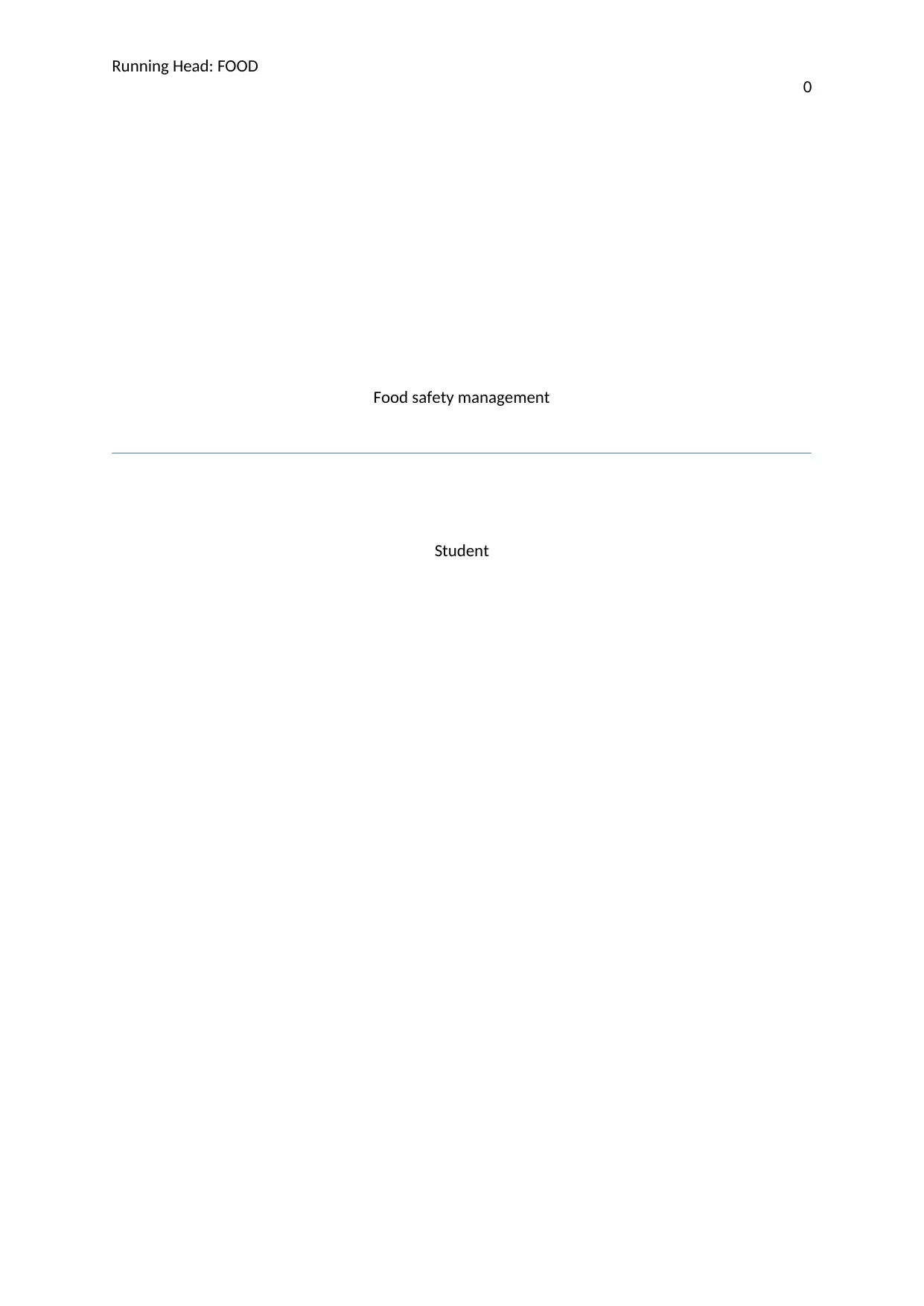
Running Head: FOOD
0
Food safety management
Student
0
Food safety management
Student
Paraphrase This Document
Need a fresh take? Get an instant paraphrase of this document with our AI Paraphraser
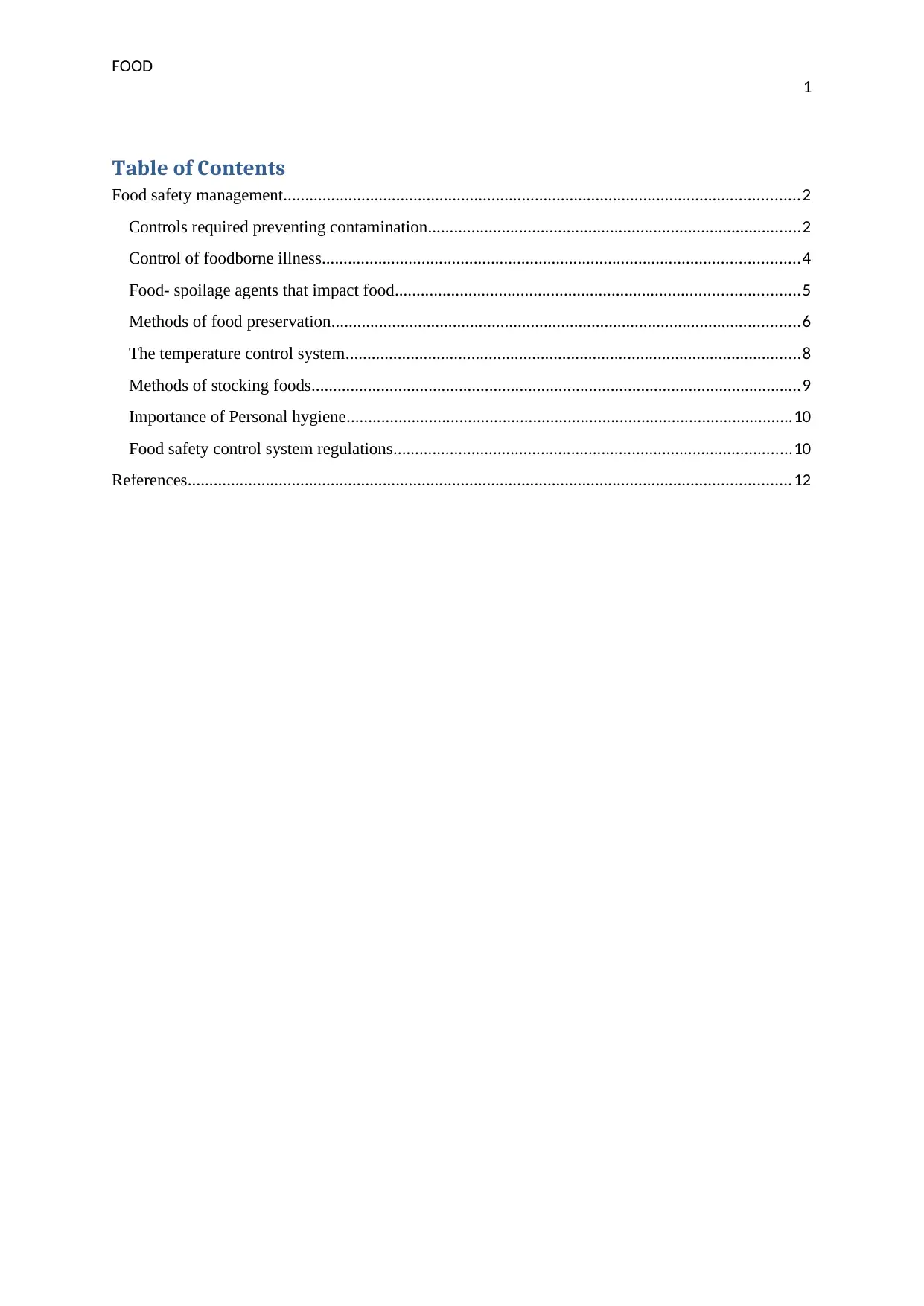
FOOD
1
Table of Contents
Food safety management.......................................................................................................................2
Controls required preventing contamination......................................................................................2
Control of foodborne illness..............................................................................................................4
Food- spoilage agents that impact food.............................................................................................5
Methods of food preservation............................................................................................................6
The temperature control system.........................................................................................................8
Methods of stocking foods.................................................................................................................9
Importance of Personal hygiene.......................................................................................................10
Food safety control system regulations............................................................................................10
References...........................................................................................................................................12
1
Table of Contents
Food safety management.......................................................................................................................2
Controls required preventing contamination......................................................................................2
Control of foodborne illness..............................................................................................................4
Food- spoilage agents that impact food.............................................................................................5
Methods of food preservation............................................................................................................6
The temperature control system.........................................................................................................8
Methods of stocking foods.................................................................................................................9
Importance of Personal hygiene.......................................................................................................10
Food safety control system regulations............................................................................................10
References...........................................................................................................................................12
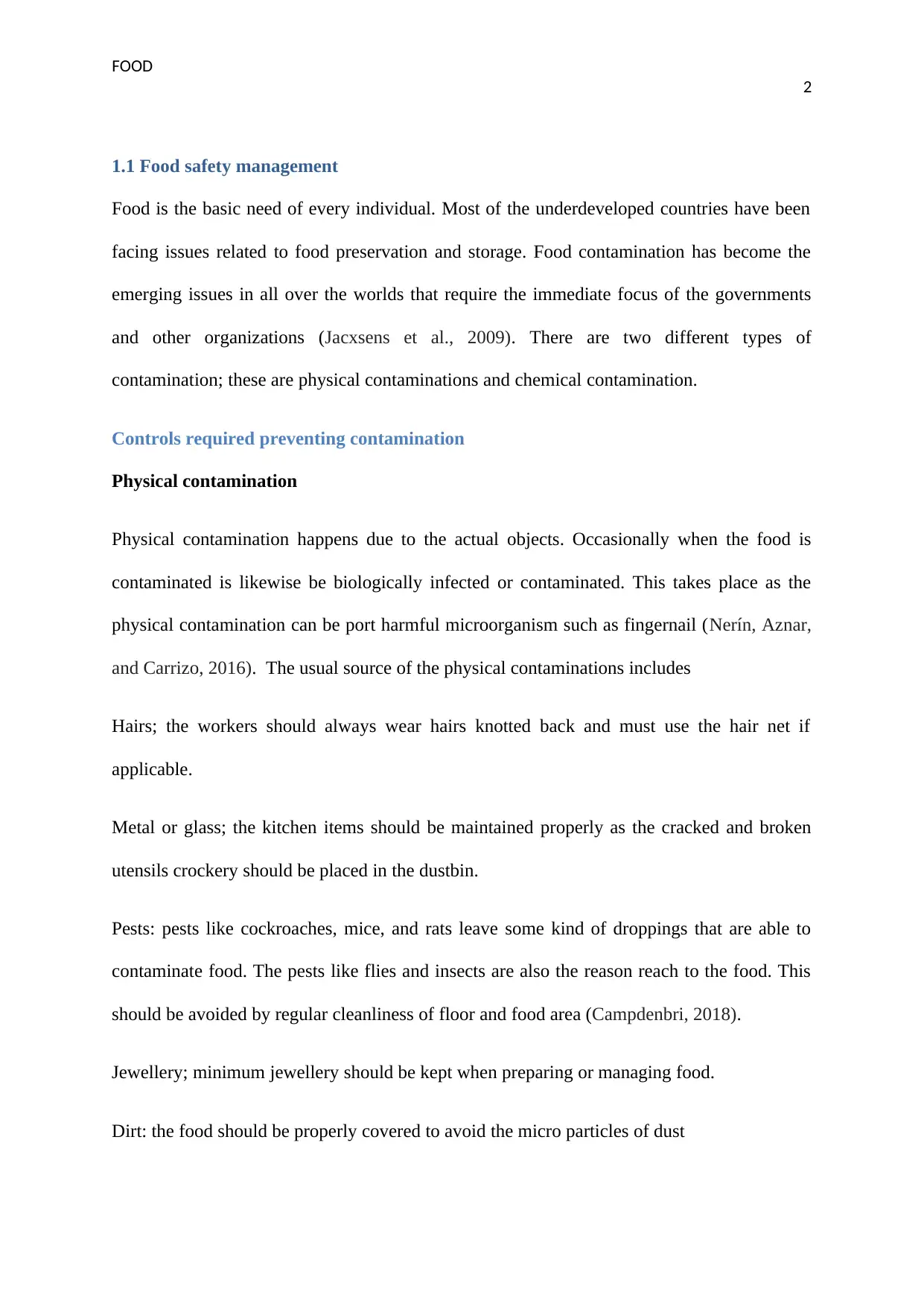
FOOD
2
1.1 Food safety management
Food is the basic need of every individual. Most of the underdeveloped countries have been
facing issues related to food preservation and storage. Food contamination has become the
emerging issues in all over the worlds that require the immediate focus of the governments
and other organizations (Jacxsens et al., 2009). There are two different types of
contamination; these are physical contaminations and chemical contamination.
Controls required preventing contamination
Physical contamination
Physical contamination happens due to the actual objects. Occasionally when the food is
contaminated is likewise be biologically infected or contaminated. This takes place as the
physical contamination can be port harmful microorganism such as fingernail (Nerín, Aznar,
and Carrizo, 2016). The usual source of the physical contaminations includes
Hairs; the workers should always wear hairs knotted back and must use the hair net if
applicable.
Metal or glass; the kitchen items should be maintained properly as the cracked and broken
utensils crockery should be placed in the dustbin.
Pests: pests like cockroaches, mice, and rats leave some kind of droppings that are able to
contaminate food. The pests like flies and insects are also the reason reach to the food. This
should be avoided by regular cleanliness of floor and food area (Campdenbri, 2018).
Jewellery; minimum jewellery should be kept when preparing or managing food.
Dirt: the food should be properly covered to avoid the micro particles of dust
2
1.1 Food safety management
Food is the basic need of every individual. Most of the underdeveloped countries have been
facing issues related to food preservation and storage. Food contamination has become the
emerging issues in all over the worlds that require the immediate focus of the governments
and other organizations (Jacxsens et al., 2009). There are two different types of
contamination; these are physical contaminations and chemical contamination.
Controls required preventing contamination
Physical contamination
Physical contamination happens due to the actual objects. Occasionally when the food is
contaminated is likewise be biologically infected or contaminated. This takes place as the
physical contamination can be port harmful microorganism such as fingernail (Nerín, Aznar,
and Carrizo, 2016). The usual source of the physical contaminations includes
Hairs; the workers should always wear hairs knotted back and must use the hair net if
applicable.
Metal or glass; the kitchen items should be maintained properly as the cracked and broken
utensils crockery should be placed in the dustbin.
Pests: pests like cockroaches, mice, and rats leave some kind of droppings that are able to
contaminate food. The pests like flies and insects are also the reason reach to the food. This
should be avoided by regular cleanliness of floor and food area (Campdenbri, 2018).
Jewellery; minimum jewellery should be kept when preparing or managing food.
Dirt: the food should be properly covered to avoid the micro particles of dust
⊘ This is a preview!⊘
Do you want full access?
Subscribe today to unlock all pages.

Trusted by 1+ million students worldwide
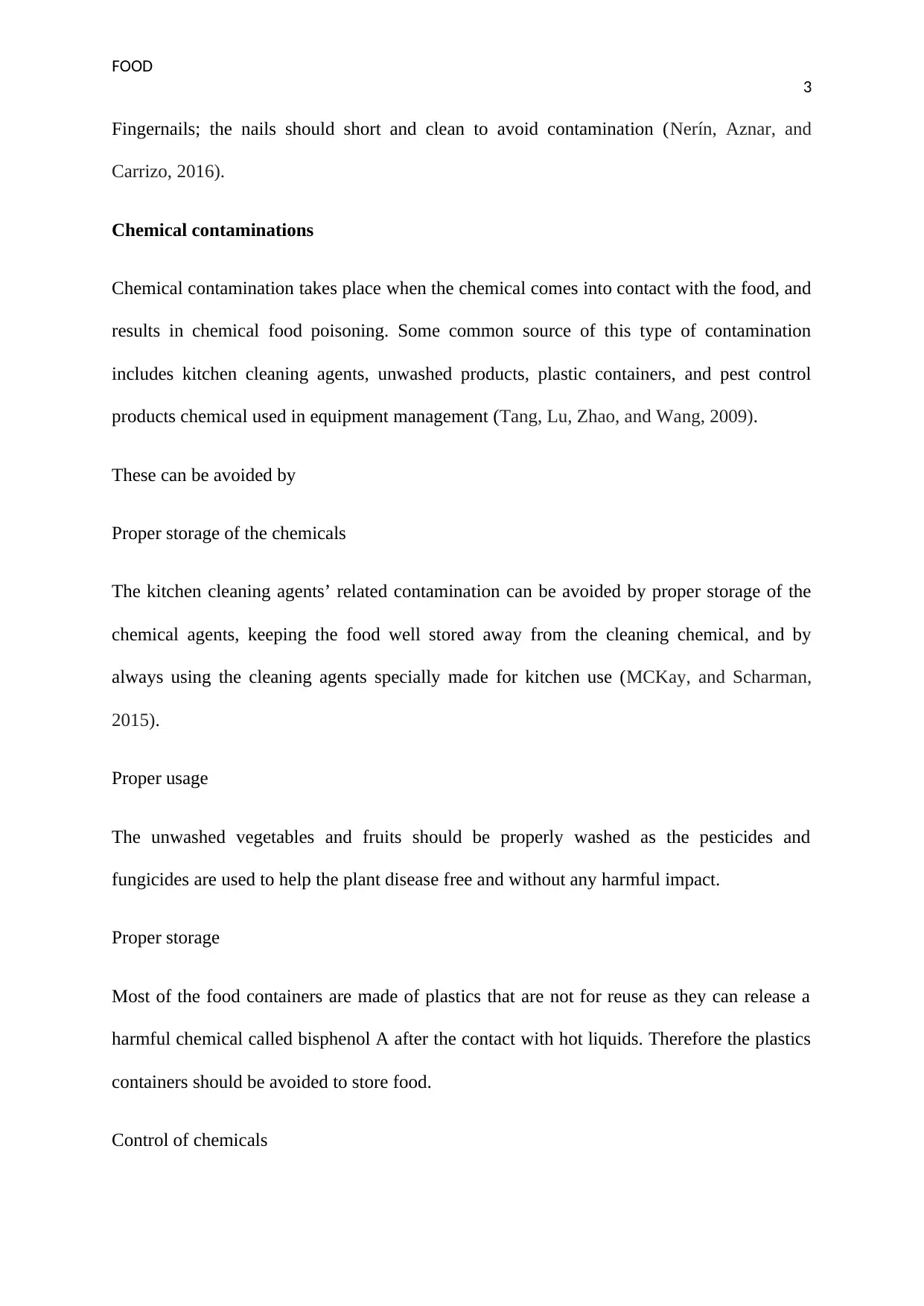
FOOD
3
Fingernails; the nails should short and clean to avoid contamination (Nerín, Aznar, and
Carrizo, 2016).
Chemical contaminations
Chemical contamination takes place when the chemical comes into contact with the food, and
results in chemical food poisoning. Some common source of this type of contamination
includes kitchen cleaning agents, unwashed products, plastic containers, and pest control
products chemical used in equipment management (Tang, Lu, Zhao, and Wang, 2009).
These can be avoided by
Proper storage of the chemicals
The kitchen cleaning agents’ related contamination can be avoided by proper storage of the
chemical agents, keeping the food well stored away from the cleaning chemical, and by
always using the cleaning agents specially made for kitchen use (MCKay, and Scharman,
2015).
Proper usage
The unwashed vegetables and fruits should be properly washed as the pesticides and
fungicides are used to help the plant disease free and without any harmful impact.
Proper storage
Most of the food containers are made of plastics that are not for reuse as they can release a
harmful chemical called bisphenol A after the contact with hot liquids. Therefore the plastics
containers should be avoided to store food.
Control of chemicals
3
Fingernails; the nails should short and clean to avoid contamination (Nerín, Aznar, and
Carrizo, 2016).
Chemical contaminations
Chemical contamination takes place when the chemical comes into contact with the food, and
results in chemical food poisoning. Some common source of this type of contamination
includes kitchen cleaning agents, unwashed products, plastic containers, and pest control
products chemical used in equipment management (Tang, Lu, Zhao, and Wang, 2009).
These can be avoided by
Proper storage of the chemicals
The kitchen cleaning agents’ related contamination can be avoided by proper storage of the
chemical agents, keeping the food well stored away from the cleaning chemical, and by
always using the cleaning agents specially made for kitchen use (MCKay, and Scharman,
2015).
Proper usage
The unwashed vegetables and fruits should be properly washed as the pesticides and
fungicides are used to help the plant disease free and without any harmful impact.
Proper storage
Most of the food containers are made of plastics that are not for reuse as they can release a
harmful chemical called bisphenol A after the contact with hot liquids. Therefore the plastics
containers should be avoided to store food.
Control of chemicals
Paraphrase This Document
Need a fresh take? Get an instant paraphrase of this document with our AI Paraphraser

FOOD
4
Products like fly spray and rat killers are highly hazardous if consumed with food. These
types of products should keep away from the food material (Tang, Lu, Zhao, and Wang,
2009).
1.3 Control of foodborne illness
HACCP Plan
HACCP is a systematic preventive strategy for food safety. It includes examination and
reduction of biological, chemical and physical threats in the productions chain of food
production from raw products, production, obtaining, handling to manufacturing, delivery,
and intakes. It can be used as the replacement for inspection, by decreasing the physical on-
site assessment to one of the confirmation and oversight of the plant's HACCP design
(Garayoa, Vitas, Díez-Leturia, and García-Jalón, 2011).
Training
Training is the most important aspects of food safety strategy. most of the foodborne illness
happens as the food handling or cooking staff is not aware of the food safety measures,
therefore the workers should be provided with education and training to spread awareness
related to food safety.
Personal hygiene makes sure that the chances of food contaminations are reduced that had the
potential to cause food poisoning. Personal hygiene is an important factor to control the
outbreak of microorganisms (Seaman, 2010).
Temperature control
The temperature management also plays a key role in reducing foodborne illnesses. The food
items should be cooked at more than 75 ° C. The food then stored in refrigerators at 8
4
Products like fly spray and rat killers are highly hazardous if consumed with food. These
types of products should keep away from the food material (Tang, Lu, Zhao, and Wang,
2009).
1.3 Control of foodborne illness
HACCP Plan
HACCP is a systematic preventive strategy for food safety. It includes examination and
reduction of biological, chemical and physical threats in the productions chain of food
production from raw products, production, obtaining, handling to manufacturing, delivery,
and intakes. It can be used as the replacement for inspection, by decreasing the physical on-
site assessment to one of the confirmation and oversight of the plant's HACCP design
(Garayoa, Vitas, Díez-Leturia, and García-Jalón, 2011).
Training
Training is the most important aspects of food safety strategy. most of the foodborne illness
happens as the food handling or cooking staff is not aware of the food safety measures,
therefore the workers should be provided with education and training to spread awareness
related to food safety.
Personal hygiene makes sure that the chances of food contaminations are reduced that had the
potential to cause food poisoning. Personal hygiene is an important factor to control the
outbreak of microorganisms (Seaman, 2010).
Temperature control
The temperature management also plays a key role in reducing foodborne illnesses. The food
items should be cooked at more than 75 ° C. The food then stored in refrigerators at 8
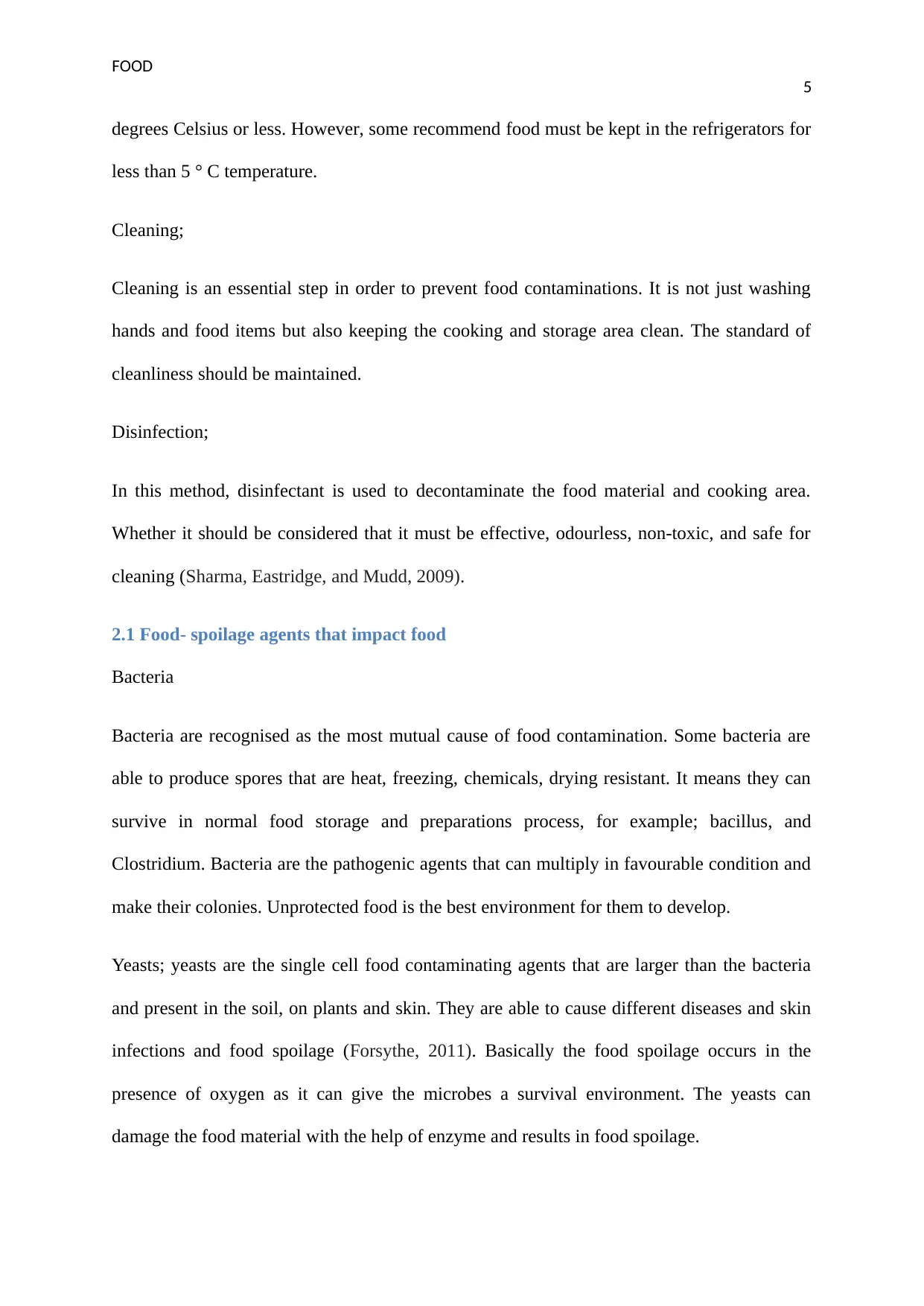
FOOD
5
degrees Celsius or less. However, some recommend food must be kept in the refrigerators for
less than 5 ° C temperature.
Cleaning;
Cleaning is an essential step in order to prevent food contaminations. It is not just washing
hands and food items but also keeping the cooking and storage area clean. The standard of
cleanliness should be maintained.
Disinfection;
In this method, disinfectant is used to decontaminate the food material and cooking area.
Whether it should be considered that it must be effective, odourless, non-toxic, and safe for
cleaning (Sharma, Eastridge, and Mudd, 2009).
2.1 Food- spoilage agents that impact food
Bacteria
Bacteria are recognised as the most mutual cause of food contamination. Some bacteria are
able to produce spores that are heat, freezing, chemicals, drying resistant. It means they can
survive in normal food storage and preparations process, for example; bacillus, and
Clostridium. Bacteria are the pathogenic agents that can multiply in favourable condition and
make their colonies. Unprotected food is the best environment for them to develop.
Yeasts; yeasts are the single cell food contaminating agents that are larger than the bacteria
and present in the soil, on plants and skin. They are able to cause different diseases and skin
infections and food spoilage (Forsythe, 2011). Basically the food spoilage occurs in the
presence of oxygen as it can give the microbes a survival environment. The yeasts can
damage the food material with the help of enzyme and results in food spoilage.
5
degrees Celsius or less. However, some recommend food must be kept in the refrigerators for
less than 5 ° C temperature.
Cleaning;
Cleaning is an essential step in order to prevent food contaminations. It is not just washing
hands and food items but also keeping the cooking and storage area clean. The standard of
cleanliness should be maintained.
Disinfection;
In this method, disinfectant is used to decontaminate the food material and cooking area.
Whether it should be considered that it must be effective, odourless, non-toxic, and safe for
cleaning (Sharma, Eastridge, and Mudd, 2009).
2.1 Food- spoilage agents that impact food
Bacteria
Bacteria are recognised as the most mutual cause of food contamination. Some bacteria are
able to produce spores that are heat, freezing, chemicals, drying resistant. It means they can
survive in normal food storage and preparations process, for example; bacillus, and
Clostridium. Bacteria are the pathogenic agents that can multiply in favourable condition and
make their colonies. Unprotected food is the best environment for them to develop.
Yeasts; yeasts are the single cell food contaminating agents that are larger than the bacteria
and present in the soil, on plants and skin. They are able to cause different diseases and skin
infections and food spoilage (Forsythe, 2011). Basically the food spoilage occurs in the
presence of oxygen as it can give the microbes a survival environment. The yeasts can
damage the food material with the help of enzyme and results in food spoilage.
⊘ This is a preview!⊘
Do you want full access?
Subscribe today to unlock all pages.

Trusted by 1+ million students worldwide
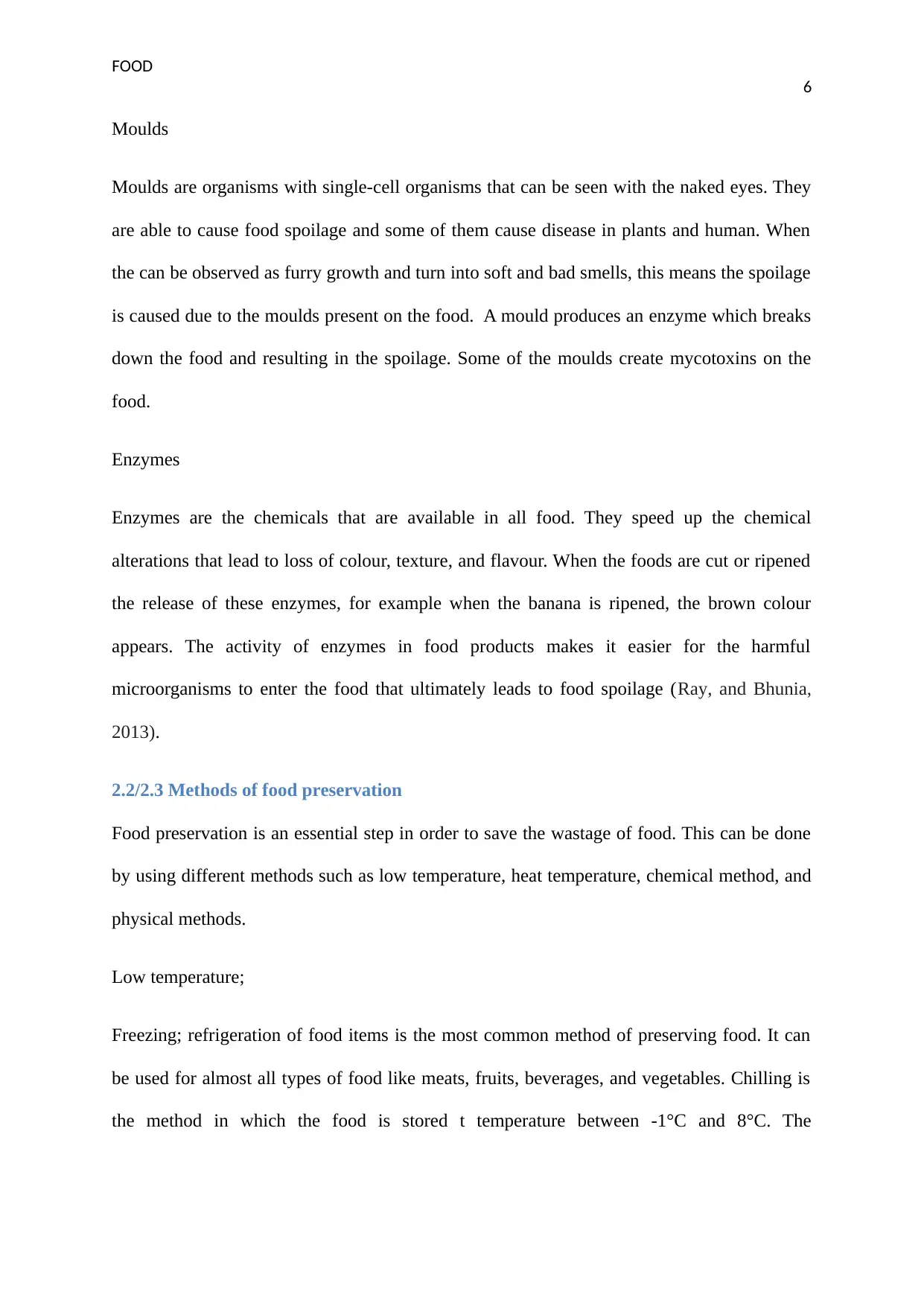
FOOD
6
Moulds
Moulds are organisms with single-cell organisms that can be seen with the naked eyes. They
are able to cause food spoilage and some of them cause disease in plants and human. When
the can be observed as furry growth and turn into soft and bad smells, this means the spoilage
is caused due to the moulds present on the food. A mould produces an enzyme which breaks
down the food and resulting in the spoilage. Some of the moulds create mycotoxins on the
food.
Enzymes
Enzymes are the chemicals that are available in all food. They speed up the chemical
alterations that lead to loss of colour, texture, and flavour. When the foods are cut or ripened
the release of these enzymes, for example when the banana is ripened, the brown colour
appears. The activity of enzymes in food products makes it easier for the harmful
microorganisms to enter the food that ultimately leads to food spoilage (Ray, and Bhunia,
2013).
2.2/2.3 Methods of food preservation
Food preservation is an essential step in order to save the wastage of food. This can be done
by using different methods such as low temperature, heat temperature, chemical method, and
physical methods.
Low temperature;
Freezing; refrigeration of food items is the most common method of preserving food. It can
be used for almost all types of food like meats, fruits, beverages, and vegetables. Chilling is
the method in which the food is stored t temperature between -1°C and 8°C. The
6
Moulds
Moulds are organisms with single-cell organisms that can be seen with the naked eyes. They
are able to cause food spoilage and some of them cause disease in plants and human. When
the can be observed as furry growth and turn into soft and bad smells, this means the spoilage
is caused due to the moulds present on the food. A mould produces an enzyme which breaks
down the food and resulting in the spoilage. Some of the moulds create mycotoxins on the
food.
Enzymes
Enzymes are the chemicals that are available in all food. They speed up the chemical
alterations that lead to loss of colour, texture, and flavour. When the foods are cut or ripened
the release of these enzymes, for example when the banana is ripened, the brown colour
appears. The activity of enzymes in food products makes it easier for the harmful
microorganisms to enter the food that ultimately leads to food spoilage (Ray, and Bhunia,
2013).
2.2/2.3 Methods of food preservation
Food preservation is an essential step in order to save the wastage of food. This can be done
by using different methods such as low temperature, heat temperature, chemical method, and
physical methods.
Low temperature;
Freezing; refrigeration of food items is the most common method of preserving food. It can
be used for almost all types of food like meats, fruits, beverages, and vegetables. Chilling is
the method in which the food is stored t temperature between -1°C and 8°C. The
Paraphrase This Document
Need a fresh take? Get an instant paraphrase of this document with our AI Paraphraser
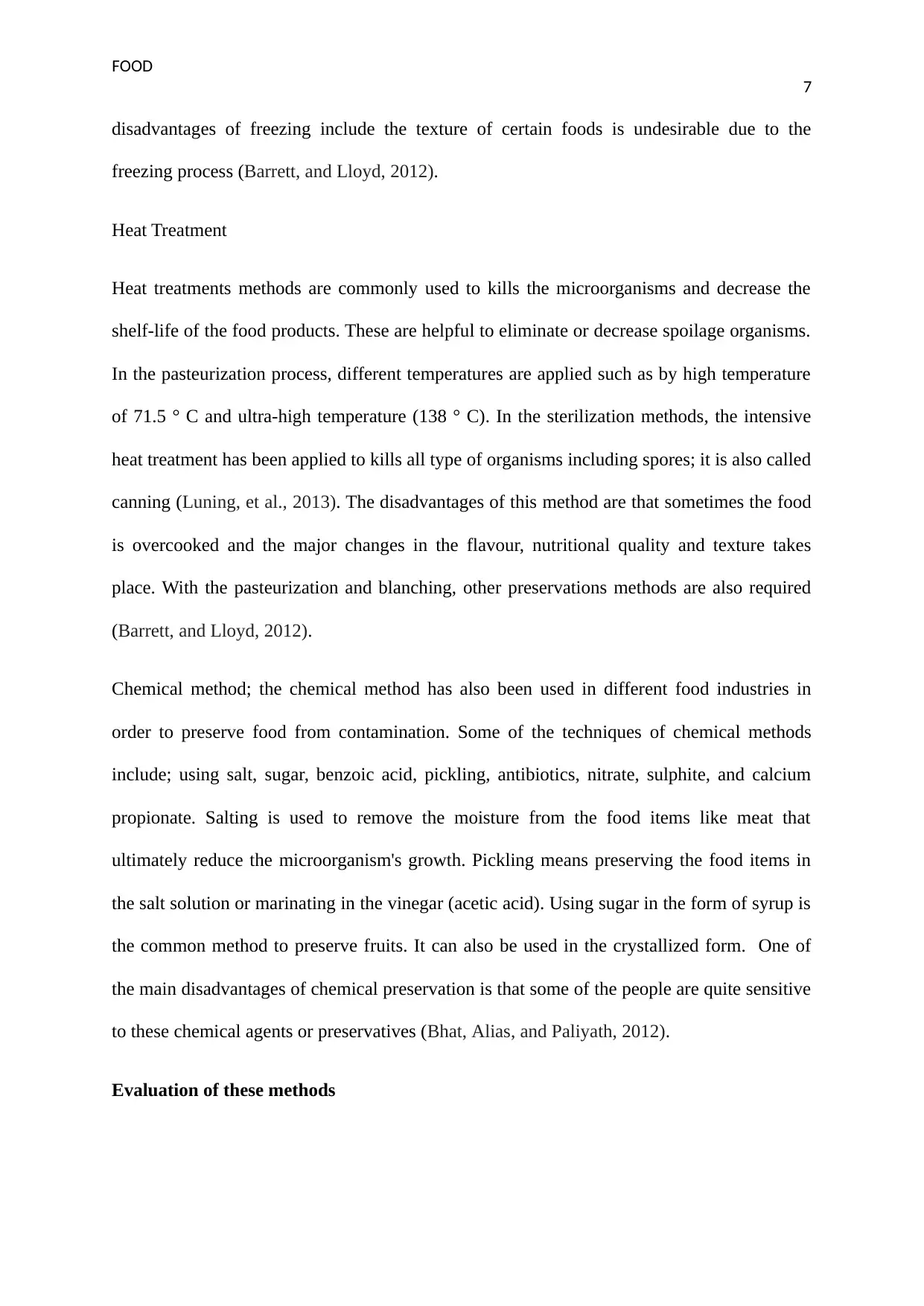
FOOD
7
disadvantages of freezing include the texture of certain foods is undesirable due to the
freezing process (Barrett, and Lloyd, 2012).
Heat Treatment
Heat treatments methods are commonly used to kills the microorganisms and decrease the
shelf-life of the food products. These are helpful to eliminate or decrease spoilage organisms.
In the pasteurization process, different temperatures are applied such as by high temperature
of 71.5 ° C and ultra-high temperature (138 ° C). In the sterilization methods, the intensive
heat treatment has been applied to kills all type of organisms including spores; it is also called
canning (Luning, et al., 2013). The disadvantages of this method are that sometimes the food
is overcooked and the major changes in the flavour, nutritional quality and texture takes
place. With the pasteurization and blanching, other preservations methods are also required
(Barrett, and Lloyd, 2012).
Chemical method; the chemical method has also been used in different food industries in
order to preserve food from contamination. Some of the techniques of chemical methods
include; using salt, sugar, benzoic acid, pickling, antibiotics, nitrate, sulphite, and calcium
propionate. Salting is used to remove the moisture from the food items like meat that
ultimately reduce the microorganism's growth. Pickling means preserving the food items in
the salt solution or marinating in the vinegar (acetic acid). Using sugar in the form of syrup is
the common method to preserve fruits. It can also be used in the crystallized form. One of
the main disadvantages of chemical preservation is that some of the people are quite sensitive
to these chemical agents or preservatives (Bhat, Alias, and Paliyath, 2012).
Evaluation of these methods
7
disadvantages of freezing include the texture of certain foods is undesirable due to the
freezing process (Barrett, and Lloyd, 2012).
Heat Treatment
Heat treatments methods are commonly used to kills the microorganisms and decrease the
shelf-life of the food products. These are helpful to eliminate or decrease spoilage organisms.
In the pasteurization process, different temperatures are applied such as by high temperature
of 71.5 ° C and ultra-high temperature (138 ° C). In the sterilization methods, the intensive
heat treatment has been applied to kills all type of organisms including spores; it is also called
canning (Luning, et al., 2013). The disadvantages of this method are that sometimes the food
is overcooked and the major changes in the flavour, nutritional quality and texture takes
place. With the pasteurization and blanching, other preservations methods are also required
(Barrett, and Lloyd, 2012).
Chemical method; the chemical method has also been used in different food industries in
order to preserve food from contamination. Some of the techniques of chemical methods
include; using salt, sugar, benzoic acid, pickling, antibiotics, nitrate, sulphite, and calcium
propionate. Salting is used to remove the moisture from the food items like meat that
ultimately reduce the microorganism's growth. Pickling means preserving the food items in
the salt solution or marinating in the vinegar (acetic acid). Using sugar in the form of syrup is
the common method to preserve fruits. It can also be used in the crystallized form. One of
the main disadvantages of chemical preservation is that some of the people are quite sensitive
to these chemical agents or preservatives (Bhat, Alias, and Paliyath, 2012).
Evaluation of these methods
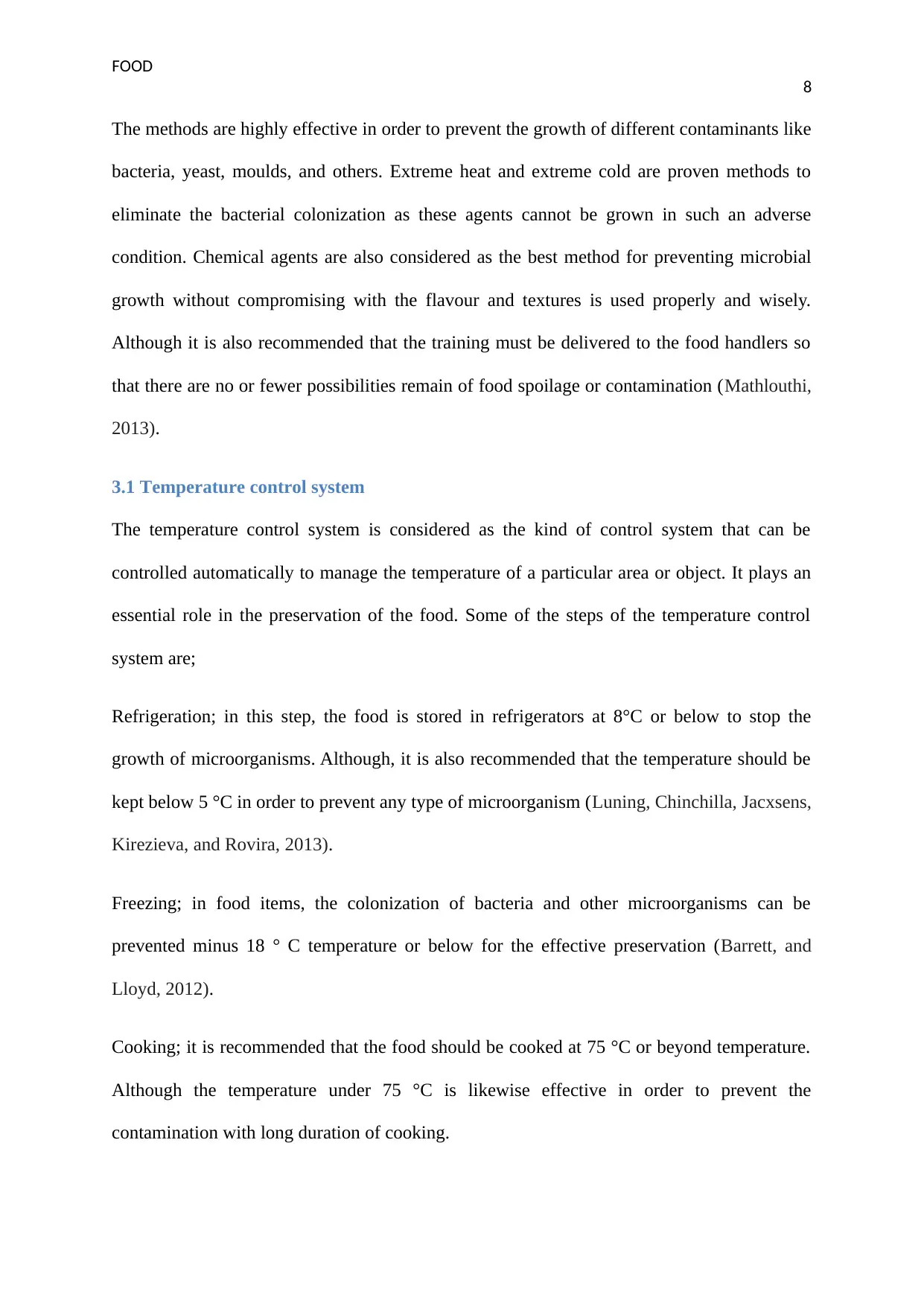
FOOD
8
The methods are highly effective in order to prevent the growth of different contaminants like
bacteria, yeast, moulds, and others. Extreme heat and extreme cold are proven methods to
eliminate the bacterial colonization as these agents cannot be grown in such an adverse
condition. Chemical agents are also considered as the best method for preventing microbial
growth without compromising with the flavour and textures is used properly and wisely.
Although it is also recommended that the training must be delivered to the food handlers so
that there are no or fewer possibilities remain of food spoilage or contamination (Mathlouthi,
2013).
3.1 Temperature control system
The temperature control system is considered as the kind of control system that can be
controlled automatically to manage the temperature of a particular area or object. It plays an
essential role in the preservation of the food. Some of the steps of the temperature control
system are;
Refrigeration; in this step, the food is stored in refrigerators at 8°C or below to stop the
growth of microorganisms. Although, it is also recommended that the temperature should be
kept below 5 °C in order to prevent any type of microorganism (Luning, Chinchilla, Jacxsens,
Kirezieva, and Rovira, 2013).
Freezing; in food items, the colonization of bacteria and other microorganisms can be
prevented minus 18 ° C temperature or below for the effective preservation (Barrett, and
Lloyd, 2012).
Cooking; it is recommended that the food should be cooked at 75 °C or beyond temperature.
Although the temperature under 75 °C is likewise effective in order to prevent the
contamination with long duration of cooking.
8
The methods are highly effective in order to prevent the growth of different contaminants like
bacteria, yeast, moulds, and others. Extreme heat and extreme cold are proven methods to
eliminate the bacterial colonization as these agents cannot be grown in such an adverse
condition. Chemical agents are also considered as the best method for preventing microbial
growth without compromising with the flavour and textures is used properly and wisely.
Although it is also recommended that the training must be delivered to the food handlers so
that there are no or fewer possibilities remain of food spoilage or contamination (Mathlouthi,
2013).
3.1 Temperature control system
The temperature control system is considered as the kind of control system that can be
controlled automatically to manage the temperature of a particular area or object. It plays an
essential role in the preservation of the food. Some of the steps of the temperature control
system are;
Refrigeration; in this step, the food is stored in refrigerators at 8°C or below to stop the
growth of microorganisms. Although, it is also recommended that the temperature should be
kept below 5 °C in order to prevent any type of microorganism (Luning, Chinchilla, Jacxsens,
Kirezieva, and Rovira, 2013).
Freezing; in food items, the colonization of bacteria and other microorganisms can be
prevented minus 18 ° C temperature or below for the effective preservation (Barrett, and
Lloyd, 2012).
Cooking; it is recommended that the food should be cooked at 75 °C or beyond temperature.
Although the temperature under 75 °C is likewise effective in order to prevent the
contamination with long duration of cooking.
⊘ This is a preview!⊘
Do you want full access?
Subscribe today to unlock all pages.

Trusted by 1+ million students worldwide
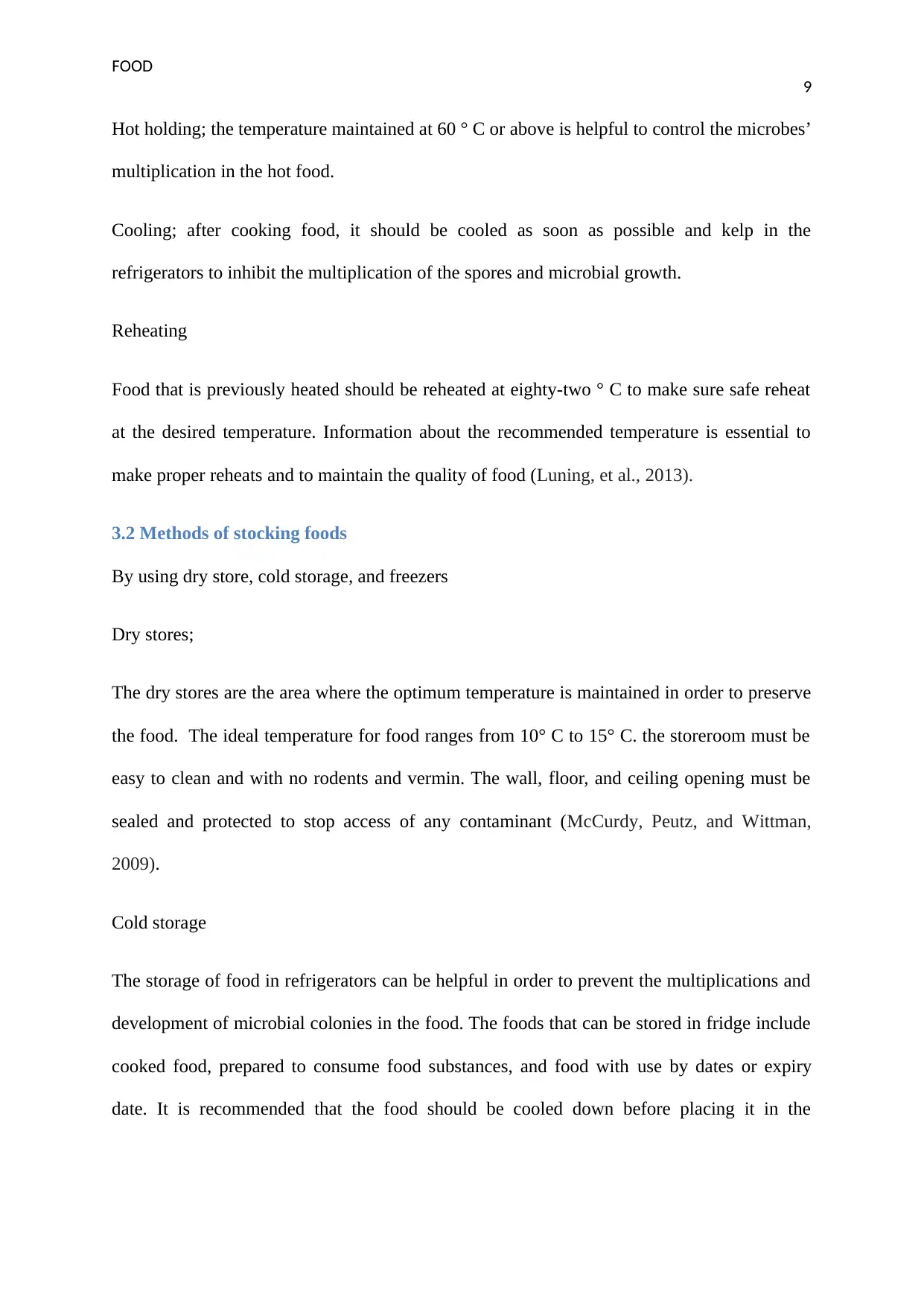
FOOD
9
Hot holding; the temperature maintained at 60 ° C or above is helpful to control the microbes’
multiplication in the hot food.
Cooling; after cooking food, it should be cooled as soon as possible and kelp in the
refrigerators to inhibit the multiplication of the spores and microbial growth.
Reheating
Food that is previously heated should be reheated at eighty-two ° C to make sure safe reheat
at the desired temperature. Information about the recommended temperature is essential to
make proper reheats and to maintain the quality of food (Luning, et al., 2013).
3.2 Methods of stocking foods
By using dry store, cold storage, and freezers
Dry stores;
The dry stores are the area where the optimum temperature is maintained in order to preserve
the food. The ideal temperature for food ranges from 10° C to 15° C. the storeroom must be
easy to clean and with no rodents and vermin. The wall, floor, and ceiling opening must be
sealed and protected to stop access of any contaminant (McCurdy, Peutz, and Wittman,
2009).
Cold storage
The storage of food in refrigerators can be helpful in order to prevent the multiplications and
development of microbial colonies in the food. The foods that can be stored in fridge include
cooked food, prepared to consume food substances, and food with use by dates or expiry
date. It is recommended that the food should be cooled down before placing it in the
9
Hot holding; the temperature maintained at 60 ° C or above is helpful to control the microbes’
multiplication in the hot food.
Cooling; after cooking food, it should be cooled as soon as possible and kelp in the
refrigerators to inhibit the multiplication of the spores and microbial growth.
Reheating
Food that is previously heated should be reheated at eighty-two ° C to make sure safe reheat
at the desired temperature. Information about the recommended temperature is essential to
make proper reheats and to maintain the quality of food (Luning, et al., 2013).
3.2 Methods of stocking foods
By using dry store, cold storage, and freezers
Dry stores;
The dry stores are the area where the optimum temperature is maintained in order to preserve
the food. The ideal temperature for food ranges from 10° C to 15° C. the storeroom must be
easy to clean and with no rodents and vermin. The wall, floor, and ceiling opening must be
sealed and protected to stop access of any contaminant (McCurdy, Peutz, and Wittman,
2009).
Cold storage
The storage of food in refrigerators can be helpful in order to prevent the multiplications and
development of microbial colonies in the food. The foods that can be stored in fridge include
cooked food, prepared to consume food substances, and food with use by dates or expiry
date. It is recommended that the food should be cooled down before placing it in the
Paraphrase This Document
Need a fresh take? Get an instant paraphrase of this document with our AI Paraphraser
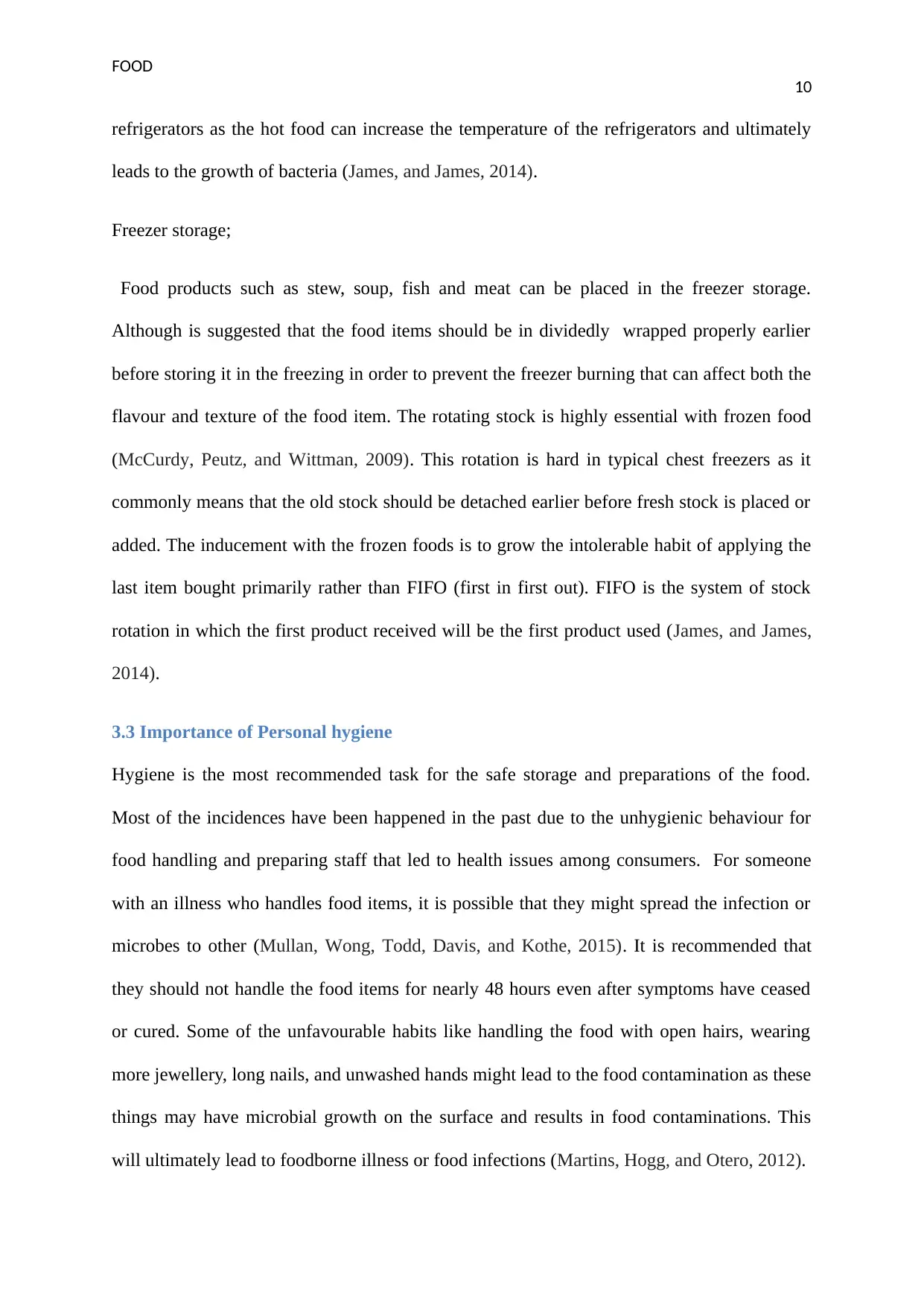
FOOD
10
refrigerators as the hot food can increase the temperature of the refrigerators and ultimately
leads to the growth of bacteria (James, and James, 2014).
Freezer storage;
Food products such as stew, soup, fish and meat can be placed in the freezer storage.
Although is suggested that the food items should be in dividedly wrapped properly earlier
before storing it in the freezing in order to prevent the freezer burning that can affect both the
flavour and texture of the food item. The rotating stock is highly essential with frozen food
(McCurdy, Peutz, and Wittman, 2009). This rotation is hard in typical chest freezers as it
commonly means that the old stock should be detached earlier before fresh stock is placed or
added. The inducement with the frozen foods is to grow the intolerable habit of applying the
last item bought primarily rather than FIFO (first in first out). FIFO is the system of stock
rotation in which the first product received will be the first product used (James, and James,
2014).
3.3 Importance of Personal hygiene
Hygiene is the most recommended task for the safe storage and preparations of the food.
Most of the incidences have been happened in the past due to the unhygienic behaviour for
food handling and preparing staff that led to health issues among consumers. For someone
with an illness who handles food items, it is possible that they might spread the infection or
microbes to other (Mullan, Wong, Todd, Davis, and Kothe, 2015). It is recommended that
they should not handle the food items for nearly 48 hours even after symptoms have ceased
or cured. Some of the unfavourable habits like handling the food with open hairs, wearing
more jewellery, long nails, and unwashed hands might lead to the food contamination as these
things may have microbial growth on the surface and results in food contaminations. This
will ultimately lead to foodborne illness or food infections (Martins, Hogg, and Otero, 2012).
10
refrigerators as the hot food can increase the temperature of the refrigerators and ultimately
leads to the growth of bacteria (James, and James, 2014).
Freezer storage;
Food products such as stew, soup, fish and meat can be placed in the freezer storage.
Although is suggested that the food items should be in dividedly wrapped properly earlier
before storing it in the freezing in order to prevent the freezer burning that can affect both the
flavour and texture of the food item. The rotating stock is highly essential with frozen food
(McCurdy, Peutz, and Wittman, 2009). This rotation is hard in typical chest freezers as it
commonly means that the old stock should be detached earlier before fresh stock is placed or
added. The inducement with the frozen foods is to grow the intolerable habit of applying the
last item bought primarily rather than FIFO (first in first out). FIFO is the system of stock
rotation in which the first product received will be the first product used (James, and James,
2014).
3.3 Importance of Personal hygiene
Hygiene is the most recommended task for the safe storage and preparations of the food.
Most of the incidences have been happened in the past due to the unhygienic behaviour for
food handling and preparing staff that led to health issues among consumers. For someone
with an illness who handles food items, it is possible that they might spread the infection or
microbes to other (Mullan, Wong, Todd, Davis, and Kothe, 2015). It is recommended that
they should not handle the food items for nearly 48 hours even after symptoms have ceased
or cured. Some of the unfavourable habits like handling the food with open hairs, wearing
more jewellery, long nails, and unwashed hands might lead to the food contamination as these
things may have microbial growth on the surface and results in food contaminations. This
will ultimately lead to foodborne illness or food infections (Martins, Hogg, and Otero, 2012).
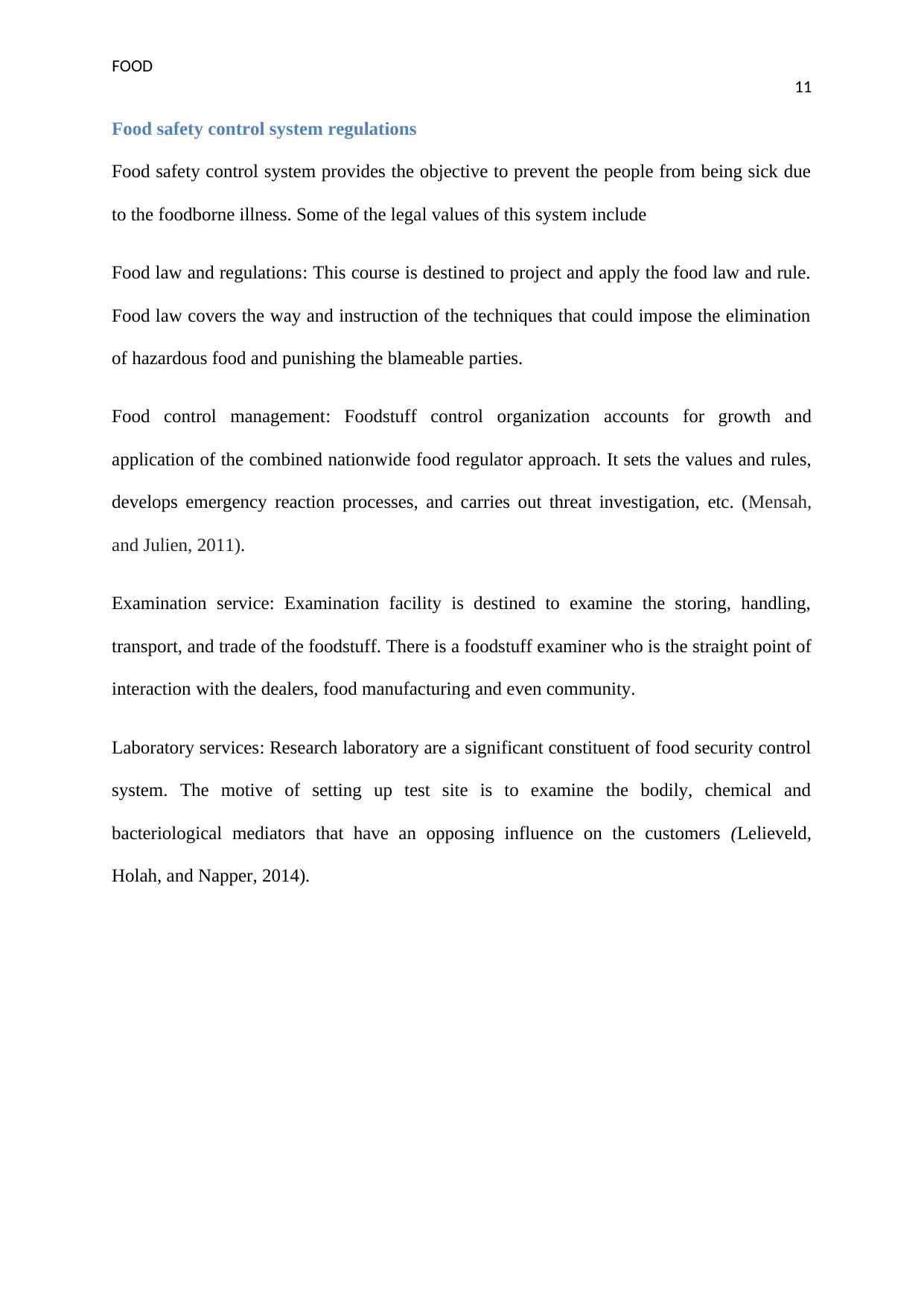
FOOD
11
Food safety control system regulations
Food safety control system provides the objective to prevent the people from being sick due
to the foodborne illness. Some of the legal values of this system include
Food law and regulations: This course is destined to project and apply the food law and rule.
Food law covers the way and instruction of the techniques that could impose the elimination
of hazardous food and punishing the blameable parties.
Food control management: Foodstuff control organization accounts for growth and
application of the combined nationwide food regulator approach. It sets the values and rules,
develops emergency reaction processes, and carries out threat investigation, etc. (Mensah,
and Julien, 2011).
Examination service: Examination facility is destined to examine the storing, handling,
transport, and trade of the foodstuff. There is a foodstuff examiner who is the straight point of
interaction with the dealers, food manufacturing and even community.
Laboratory services: Research laboratory are a significant constituent of food security control
system. The motive of setting up test site is to examine the bodily, chemical and
bacteriological mediators that have an opposing influence on the customers (Lelieveld,
Holah, and Napper, 2014).
11
Food safety control system regulations
Food safety control system provides the objective to prevent the people from being sick due
to the foodborne illness. Some of the legal values of this system include
Food law and regulations: This course is destined to project and apply the food law and rule.
Food law covers the way and instruction of the techniques that could impose the elimination
of hazardous food and punishing the blameable parties.
Food control management: Foodstuff control organization accounts for growth and
application of the combined nationwide food regulator approach. It sets the values and rules,
develops emergency reaction processes, and carries out threat investigation, etc. (Mensah,
and Julien, 2011).
Examination service: Examination facility is destined to examine the storing, handling,
transport, and trade of the foodstuff. There is a foodstuff examiner who is the straight point of
interaction with the dealers, food manufacturing and even community.
Laboratory services: Research laboratory are a significant constituent of food security control
system. The motive of setting up test site is to examine the bodily, chemical and
bacteriological mediators that have an opposing influence on the customers (Lelieveld,
Holah, and Napper, 2014).
⊘ This is a preview!⊘
Do you want full access?
Subscribe today to unlock all pages.

Trusted by 1+ million students worldwide
1 out of 15
Related Documents
Your All-in-One AI-Powered Toolkit for Academic Success.
+13062052269
info@desklib.com
Available 24*7 on WhatsApp / Email
![[object Object]](/_next/static/media/star-bottom.7253800d.svg)
Unlock your academic potential
Copyright © 2020–2025 A2Z Services. All Rights Reserved. Developed and managed by ZUCOL.





